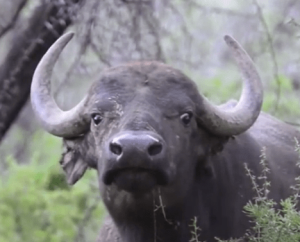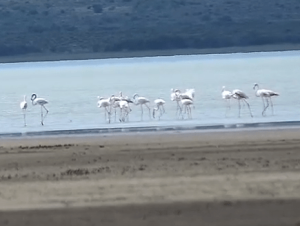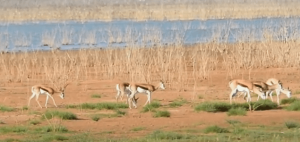Formed hundreds of millions of years ago, the Karoo of South Africa is one of the great natural wonders of the world. Camdeboo National Park provides the visitor with insights into the unique landscape and ecosystem of the Karoo, not to mention awesome scenic beauty. The vision for the future is ultimately to link Camdeboo National Park with Mountain Zebra National Park, protecting a huge diversity of plant and animal species. Early history of the park includes use of the area by early, middle and later stone age people. Evidence of occupation by these people can be found in the form of stone age industry sites on the south eastern plains of the park. Artifacts found in these sites include bored stones, percussion-made hand axes, scrapers, blades and grinding stones.
Visitor Tips
- There are a number of 4×4 routes that can be explored in both the eastern and western sections of the Park.
- Day visitors are welcome and can make use of various attractions such as the Valley of Desolation, Game Viewing Area and a number of picnic sites.
- As outdoor lighting in the camps is limited, a torch/headlamp is required when walking outside at night.
Valley of Desolation
With an estimated 100 000 people who visit this site each year, the Valley of Desolation is a premier tourist attraction in the region.
The road to the top of the valley was tarred in 1978 and today provides tourists with easy access to the viewpoints with their panoramic views of the landscape. The viewpoints at the Valley itself provide a breath-taking view of piled dolerite columns against the backdrop of the plains of the Great Karoo and a timeless sense of wonder at a landscape said to be the product of the erosive and volcanic forces of nature over a period of 200 million years.
Lakeview Tented Camp
Four rustic furnished tents provide a relaxed nature experience. Each tent sleeps two people and has a braai unit, fridge, table and two chairs. Bedding and towels are provided. There is a communal kitchen equipped with stove plates, cooking and eating utensils and microwave. Tents are booked as individual units but there is also a communal braai area for group use. Communal showers and toilets are provided.
Picnic Areas
Camdeboo National Park has six picnic areas with braai and ablution facilities:
- Impunzi picnic area in the game viewing Area has four sites.
- Ribbokberg picnic area on the way to the Valley of Desolation has four sites.
- Mountain Drive picnic area has seven widely-spaced sites in the Mountain Drive area.
- Babergat picnic area has two sites adjacent to the Nqweba Dam wall.
- Piekniekbos picnic area has 12 sites on the western shore of the Nqweba Dam
- The Boat Club picnic area has four sites (for exclusive use of boat club members).
Animals
Forty-three mammal species are found within the park of which 11 are rodents and 13 carnivores. 
The crepuscular bat-eared fox is often seen hunting by the use of its large ears to locate insects while the communal behaviour of the suricate (meerkat) can be fascinating to watch.
Vervet monkeys, seen often with tails shortened to varying degree by aggressive interaction within the troop, inhabit the Acacia forests and adjacent plant communities. These primates should never be fed, since this practice subverts their natural behaviour and creates problem animals, which may later have to be destroyed.
Game animals regularly sighted by visitors include steenbok, springbok, blesbok and black wildebeest in open areas. Thicket inhabitants include the kudu and grey duiker which are common as well as the less often seen Cape buffalo. Red hartebeest and gemsbok are frequently observed in the transitional vegetation types. Cape Mountain Zebra may be seen from time to time but prefer the more mountainous areas of the reserve. The klipspringer is well-adapted to the rocky habitats of the park with hooves adapted to enhance their grip on the rocks due to pneumatic spaces in the tips of the hooves.
Birding
Nearly 250 bird species have been recorded in the park, with an interesting ecotonal mix including species typical of both the Great Karoo and Eastern region avifaunas.
The ostrich is perhaps the most well-known example of a bird adapted to life on the plains – it can cover up to 32km per day.
The most common birds in the Game Viewing Area are: pale chanting goshawk, rock kestrel, Namaqua dove, Diederik cuckoo, speckled mousebird, brownhooded kingfisher, cardinal woodpecker, lesser honeyguide, anteating chat, longbilled crombec, Levaillant’s cisticola, neddicky and titbabbler.
Climate
Camdeboo National Park is located in a summer rainfall, semi-desert area.
Summers are very hot and winters can be very cold. During the summer months, visitors are advised to confine their activities to early mornings and late afternoons. Most of the average rainfall of 336mm per annum occurs in summer and autumn, with a peak in March. Thunderstorms and high temperatures are common during the summer months while snowfalls can occur in the high-lying areas in winter.
Contact Information
For enquiries email Camdeboo National Park or:
- Tel: (049) 892 3453
- Fax: (049) 892 3456
- Camdeboo National Park
P. O. Box 349
Graaff-Reinet
6280

Visit Eastern Cape National Parks for more national park information.

